AMD Zen 4 Ryzen 9 7950X and Ryzen 5 7600X Review: Retaking The High-End
by Ryan Smith & Gavin Bonshor on September 26, 2022 9:00 AM ESTCPU Benchmark Performance: Power, Web, And Science
Our previous set of ‘office’ benchmarks has often been a mix of science and synthetics, so this time we wanted to keep our office section purely on real-world performance. We've also incorporated our power and science testing into this section too.
In this version of our test suite, all the science-focused tests that aren’t ‘simulation’ work are now in our science section. Where possible these benchmarks have been optimized with the latest in vector instructions.
We are using DDR5 memory on the Ryzen 9 7950X and Ryzen 5 7600X, as well as Intel's 12th Gen (Alder Lake) processors at the following settings:
- DDR5-5200 CL44 - Ryzen 7000
- DDR5-4800 (B) CL40 - Intel 12th Gen
All other CPUs such as Ryzen 5000 and 3000 were tested at the relevant JEDEC settings as per the processor's individual memory support with DDR4.
Power
The nature of reporting processor power consumption has become, in part, a dystopian nightmare. Historically the peak power consumption of a processor, as purchased, is given by its Thermal Design Power (TDP, or PL1). For many markets, such as embedded processors, that value of TDP still signifies the peak power consumption. For the processors we test at AnandTech, either desktop, notebook, or enterprise, this is not always the case.
Modern high-performance processors implement a feature called Turbo. This allows, usually for a limited time, a processor to go beyond its rated frequency. Exactly how far the processor goes depends on a few factors, such as the Turbo Power Limit (PL2), whether the peak frequency is hard coded, the thermals, and the power delivery. Turbo can sometimes be very aggressive, allowing power values 2.5x above the rated TDP.
AMD and Intel have different definitions for TDP but are broadly speaking, applied the same. The difference comes from turbo modes, turbo limits, turbo budgets, and how the processors manage that power balance. These topics are 10000-12000 word articles in their own right, and we’ve got a few articles worth reading on the topic.
- Why Intel Processors Draw More Power Than Expected: TDP and Turbo Explained
- Talking TDP, Turbo and Overclocking: An Interview with Intel Fellow Guy Therien
- Reaching for Turbo: Aligning Perception with AMD’s Frequency Metrics
- Intel’s TDP Shenanigans Hurts Everyone
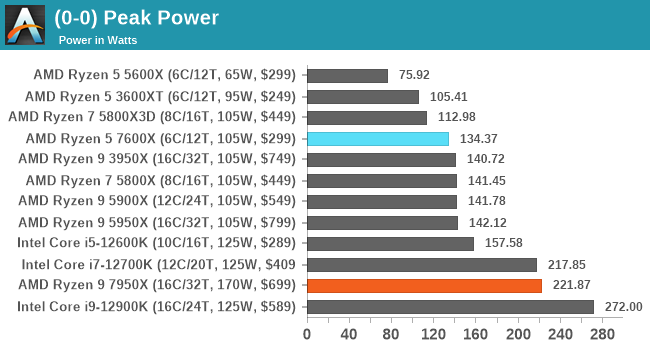
Looking at the results of our Peak Power test, the Ryzen 9 7950X topped out at 221.8 W, which is around 30% higher than the TDP of 170 W it comes with. As stated by AMD, the Power Package Tracking or PPT limit for AM5 motherboards when used with 170W TDP Ryzen 7000 SKUs will be 230 W. Still, while it draws more power than its generational predecessors such as Zen 3 and Zen 2, the Zen 4-based Ryzen 7000 series benefits from higher core clock speeds, a higher single core boost frequency, as well as other implementations around TSMC's 5 nm manufacturing process.
The AMD Ryzen 5 7600X is more aimed at the mid-range, and as such has a lower overall power draw, with the peak power figures in our testing reaching 134.3 W. This is around the same levels of power draw as the Ryzen 9 3950 X, the Ryzen 9 5900X, and the Ryzen 7 5800X. Per AMD's specifications, the Ryzen 5 7600X has a TDP of 105 W, with around a 27 % variance in peak power compared to TDP.
From our testing, so far, it seems that Ryzen 7000 when combined with a premium X670E motherboard allows for up to 30% in terms of extra power allowances for higher single-core boost and overall faster all-core frequencies.
Web
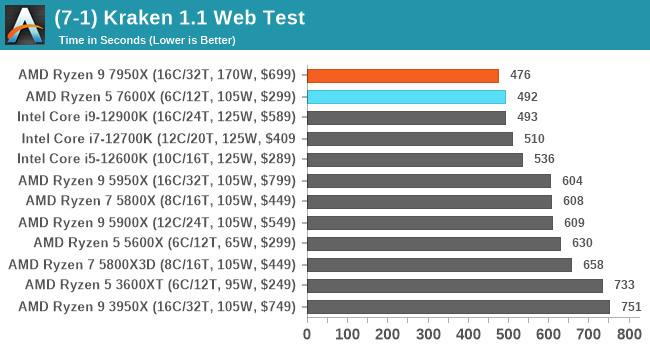
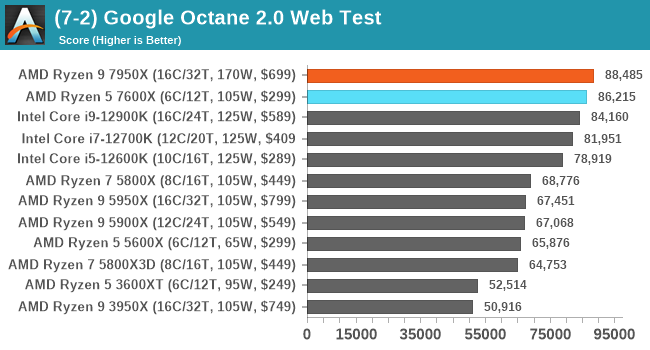
In our web tests, the overall improvements in IPC, frequency, clock speeds, and the switch to DDR5 all play a part in performance here. Both the Ryzen 9 7950X and Ryzen 7 7600X top our charts in regards to web testing, although performance isn't as apparent as it should be in other areas.
Science
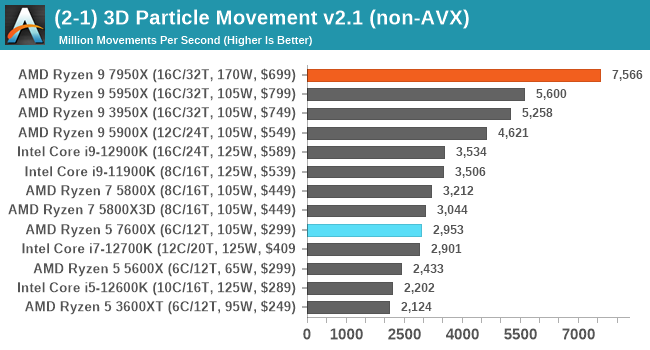
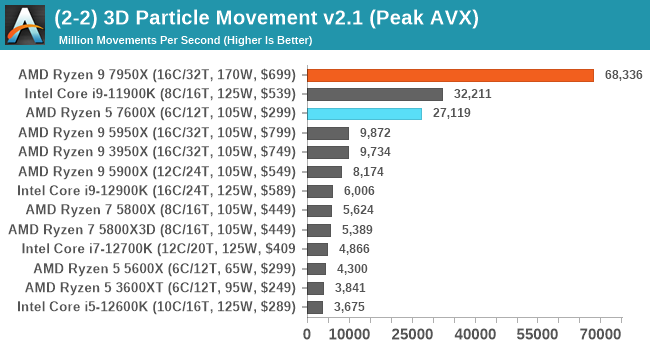
For our 3DPM v2.1 testing, we added in the Intel Core i9-11900K (Rocket Lake) to show performance across AVX workloads. Although Intel officially fused off the AVX2/512 extensions on Alder Lake which did cause a little controversy and gave the impression that AVX-512 on consumer platforms was dead. AMD clearly believes the opposite, as it has implemented it so that AVX-512 runs two cycles over a 256-bit wide instruction. The performance of the Ryzen 9 7950X here is phenomenal, although the Core i9-11900K which did indeed feature AVX instruction sets in the silicon, is still better than the Ryzen 5 7600X with AVX workloads.
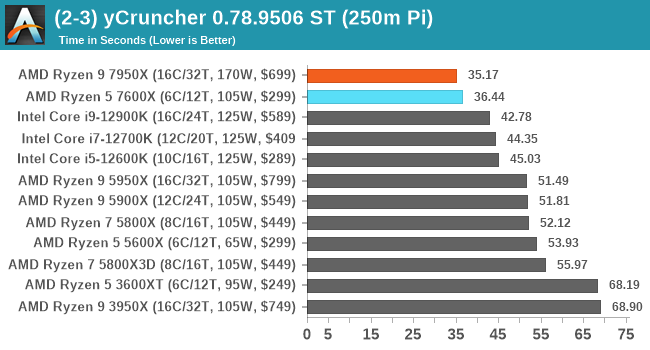
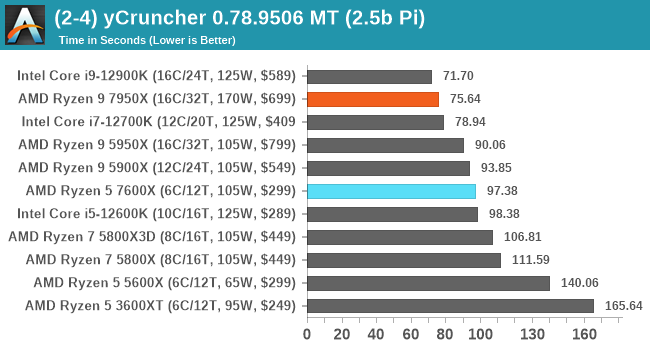
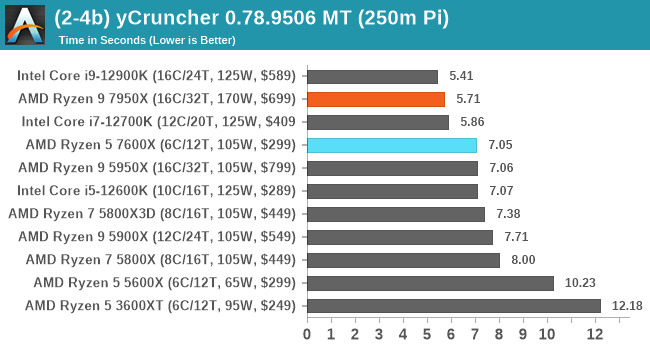
Focusing on our more science-based tests, both the Ryzen 9 7950X and Ryzen 5 7600X perform well against the competition. In our 3DPMv2.1 test in non-AVX, the Ryzen 9 7950X provided a jump of 35% in performance against the previous generation Ryzen 9 5950X processor.
Interestingly, in our yCruncher 0.78 test, the Ryzen 9 7950X and the Core i9-12900K trade blows consistently, although the Ryzen 5 7600X performs well for its price point.










205 Comments
View All Comments
jakky567 - Monday, September 26, 2022 - link
I'm confused by USB 2, do you mean USB 2.0 or USB 4v2, or what? ReplyRyan Smith - Monday, September 26, 2022 - link
Yes, USB 2.0.USB 4v2 was just announced. We're still some time off from it showing up in any AMD products. Reply
Myrandex - Thursday, September 29, 2022 - link
lol did they share any reason why to give a single USB 2.0 port? ReplyRyan Smith - Friday, September 30, 2022 - link
Basic, low complexity I/O. Implementing a USB 2.x port is relatively simple these days. It's a bit of a failsafe, really. ReplyLuxZg - Monday, September 26, 2022 - link
One question and one observation.Q: ECO mode says 170W -> 105W but tested CPU was 170W -> 65W. Is that a typo or was that just to show off? I wish that sample graph showed 7600X at 105W and 65W in addition to 7950X at 170/105/65W.
Observation: 5800X is 260$ on Amazon. So with cheaper DDR4, cheaper MBOs, and cheaper CPU, it will be big competition inside AMD's own house. At least for those that don't "need" PCIe 5.0 or future proofing. Reply
andrewaggb - Monday, September 26, 2022 - link
I was confused by that as well.The way I read the paragraph suggested 170w eco mode is 105w but then it's stated the cpu was tested at 65w. Was it meant to say 105w or can a 170w be dialed down to 65w and the test is correctly labelled? Reply
Otritus - Monday, September 26, 2022 - link
By default while under 95*C, 203*F, 368.15K, the 7950X will have a TDP of 170 watts and use up to 230 watts of power. You can think of it like TDP and Turbo Power on Intel. Eco mode will reduce TDP to 105 watts (and use up to 142 watts??). You can manually set the power limits, and Anandtech set them to 65 watts to demonstrate efficiency. Meaning the 7950X was not in eco mode, but a manual mode more efficient than eco mode. Replyuefi - Monday, September 26, 2022 - link
Just by supporting Microsoft's cloud connected hardware DRM makes the 7000 series vastly inferior to all current Intel CPUs. ReplyMakaveli - Monday, September 26, 2022 - link
So you are saying intel is not going to implement this in any of their Future processors?If the Raptorlake review shows it supports that also i'm going to back to this message. Reply
socket420 - Monday, September 26, 2022 - link
I don't understand where these "intel rulez because they don't use pluton!!" people are coming from - one, the Intel Management Engine... exists, and two, Microsoft explicitly stated that Pluton was developed with the support of AMD, Intel and Qualcomm back in 2020. Intel is clearly on-board with it and I expect to see Pluton included in Raptor Lake or Meteor Lake, they're just late to the party because that's what Intel does best, I guess? Reply